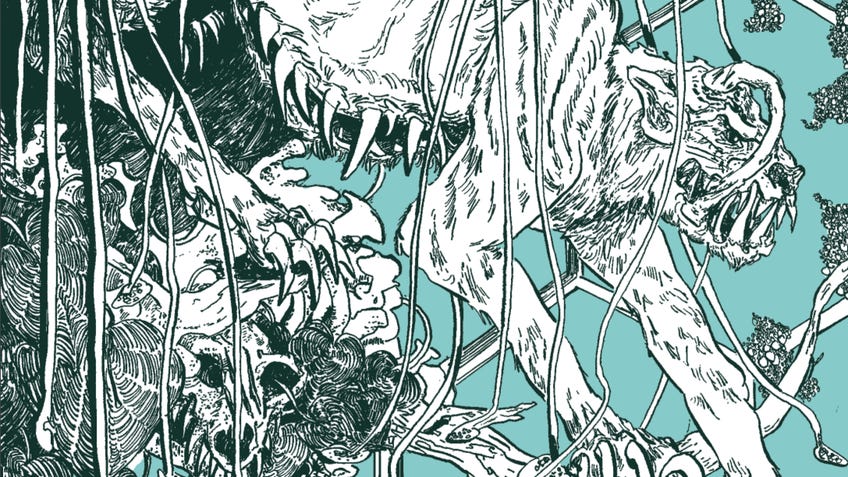Games Omnivorous’ adventure books show evocative art thrives under weird constraints
The minimalist RPG publisher sets ten rules for its adventure books with fascinating results.
Adventure books and zines too often get the short shrift when discussing tabletop RPGs. Sure, they don’t garner the same excitement and roleplay depth as a brand new system or setting book. And yes, the vast swath of available titles makes browsing them akin to pulling a single drop of water from an entire ocean.
But they are quickly becoming my favourite form of writing in this hobby - a melding of illustration, poetry and design that doesn't sprawl across 250 pages but instead conveys thought through every line and stroke. Take the odd collection from Games Omnivorous as an example. Two recent releases from the Portuguese publisher, Eat the Rich and Mouth Brood, first captured my attention with their titles and then wholly won over my affection once I cracked their covers.
Eat the Rich and Mouth Brood, created by Ambika Kirkland and Amanda Lee Franck, respectively, follow a set of nine design rules (and one lost rule) collectively called the Manifestus Omnivorous. These principles start simple enough but quickly start communicating some deeper purpose. For ease, here’s the full list from Games Omnivorous’ website:
- All books are adventures.
- The adventures must be system-agnostic.
- The adventures must take place on Earth.
- The adventures can only have one location.
- The adventures can only have one monster.
- The adventures must include saprophagy or osteophagy.
- The adventures must include a voracious eater.
- The adventures must have less than 6,666 words.
- The adventures can only be in two colours.
- The Lost Rule: the adventures cannot have good taste.
By rule four or five, you might be intrigued, or at least puzzled: one location and only one monster? How is that supposed to keep my party sufficiently interested or threatened over the course of one to three evenings? Things become gruesome by rule seven, and you might begin to think the catalogue of experience will all tend towards gore, brutality and other macabre, horror-adjacent themes. I, too, was once naive like you, hypothetical reader.
Kirkland and Franck’s adventures both follow the same set of rules but arrive at wholly divergent locations. Mouth Brood presents a hermetically sealed biosphere that has been left untouched since prehistoric times, the life within evolving to feed on itself without any loss of energy. The players walk into the efficient engine of ecological cannibalism with two goals: survival and as much research as possible. The lifeforms inside might as well be alien, and they certainly don’t react the way humans would expect.

Dozens of fauna and flora are described in Mouth Brood’s expansive bestiary, which provides a random behavior table and how it reacts to observation. The party must hex crawl through the dome, ascending from the undergrowth, through the canopy and into the emergent zone to document as much as possible in their field notes. A single apex predator sleeps among the branches like a furry Sword of Damocles. The vibes smack of the 2016 film Arrival, and the hook of sending would-be experts into an alien landscape reads like the Strugatsky brothers’ novel, Roadside Picnic.
In contrast, Eat the Rich leans into sanguine apocalyptic fantasy and tasks players with ascending the Godspire in search of a divine being who might cure the flesh hunger that has stricken most of the population living below. What they find inside is simply another form of nightmare, a realm of powerful artifacts as likely to maim as empower, a decrepit technology cult living in fear of a ravenous god and the ghosts of what once was (or perhaps never was).
On paper, this is much closer to a classic dungeon crawl with a single path through rooms that all house danger and opportunity. Kirkland outlines starting equipment and specific character generation tables that match the desiccated world above which the Godspire floats, along with rules for becoming infected with The Hunger and its progressive stages. It’s also a clear conveying of politics through design - if the name didn’t already give it away - and one that feels successful in walking the tightrope between incisive critique and saccharine morality tale.
There’s a well-heeled adage that limitations breed great art, and the Manifestus Omnivorous seems to mark a notch in favour of those words ringing true. Both of these adventures managed to create uniquely inspiring and horrible worlds from the same set of rules. Moreso, their system-agnostic nature means that each will play differently under various systems. Pair Eat the Rich with Mörk Borg to turn the pain and suffering up to 11. Mouth Brood would take great advantage of the higher stakes and looming threats of Free League’s Things from the Flood, while both the GUMSHOE system and the Alien RPG would further lean into the creeping dread waiting just above the players’ heads.
I came away from Games Omnivorous’ latest batch of adventures with a fresh perspective on the supplements too often playing second fiddle to larger campaigns. Trading grand horizons for dense immediate surroundings means your roleplay group might actually see the experience from start to finish, for once, and they offer the perfect opportunity to try an entirely new system or play them straight from the pages. Here’s to adventures and the bizarre rules that give them shape.


